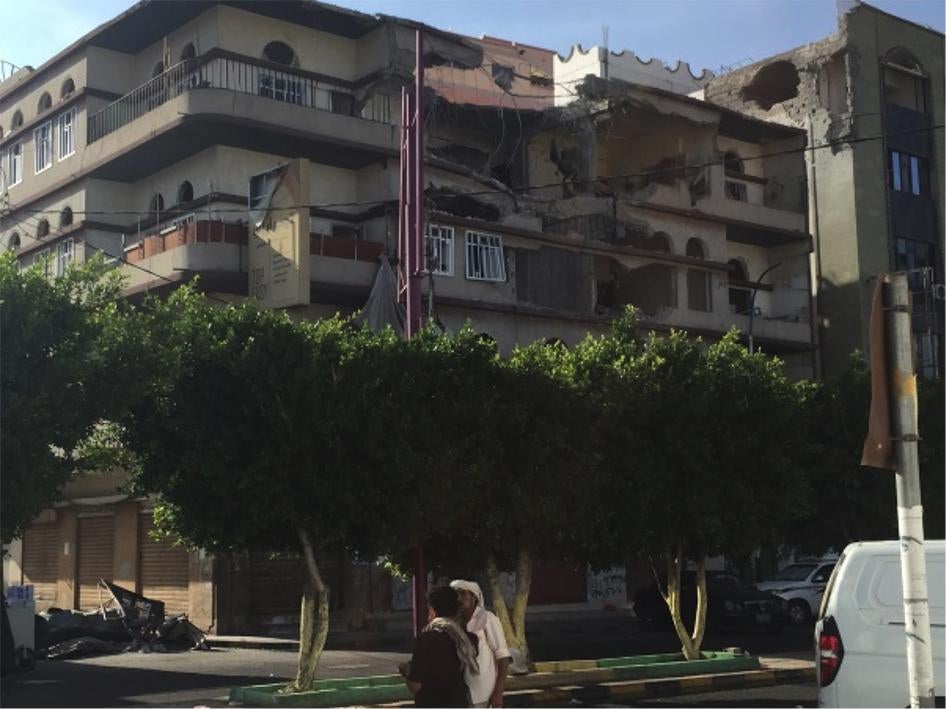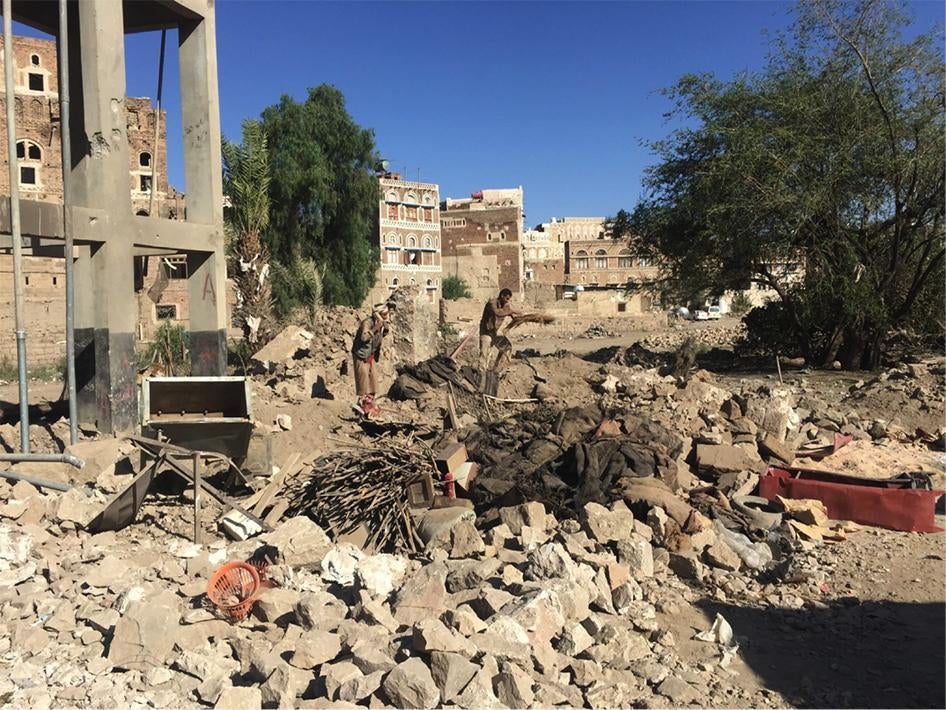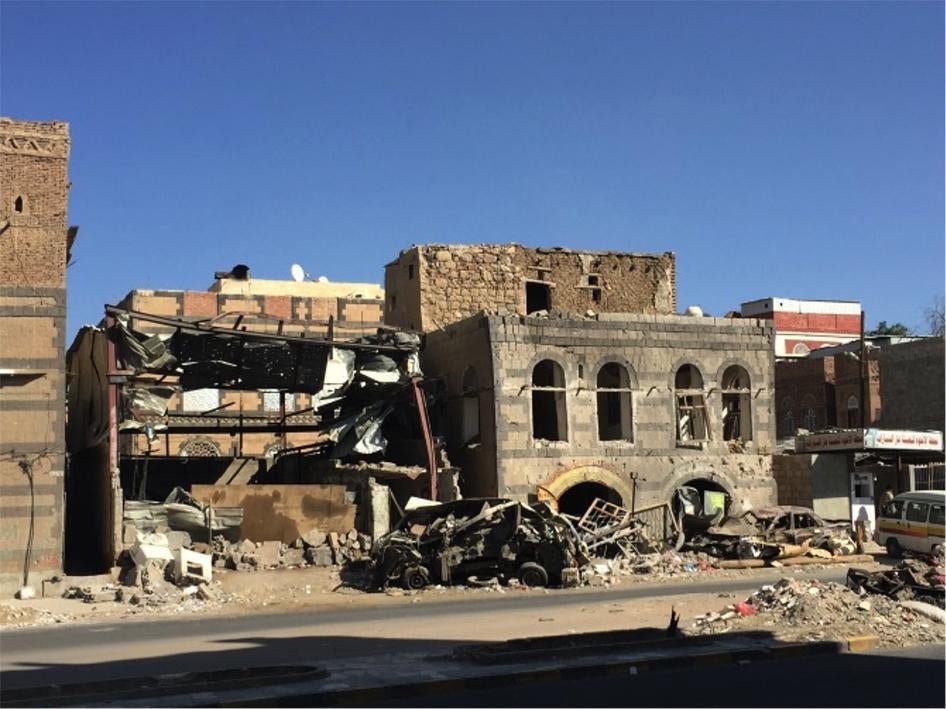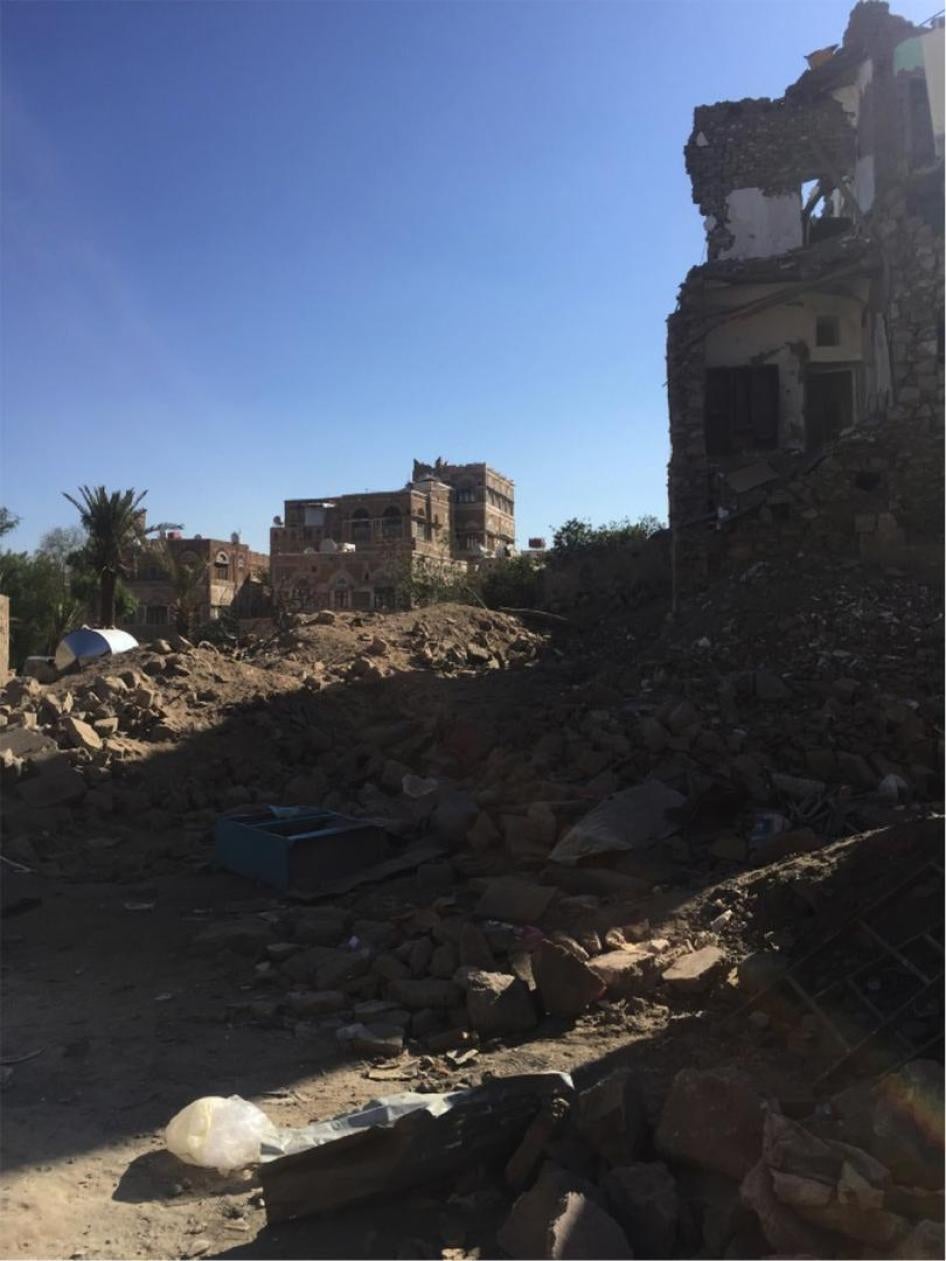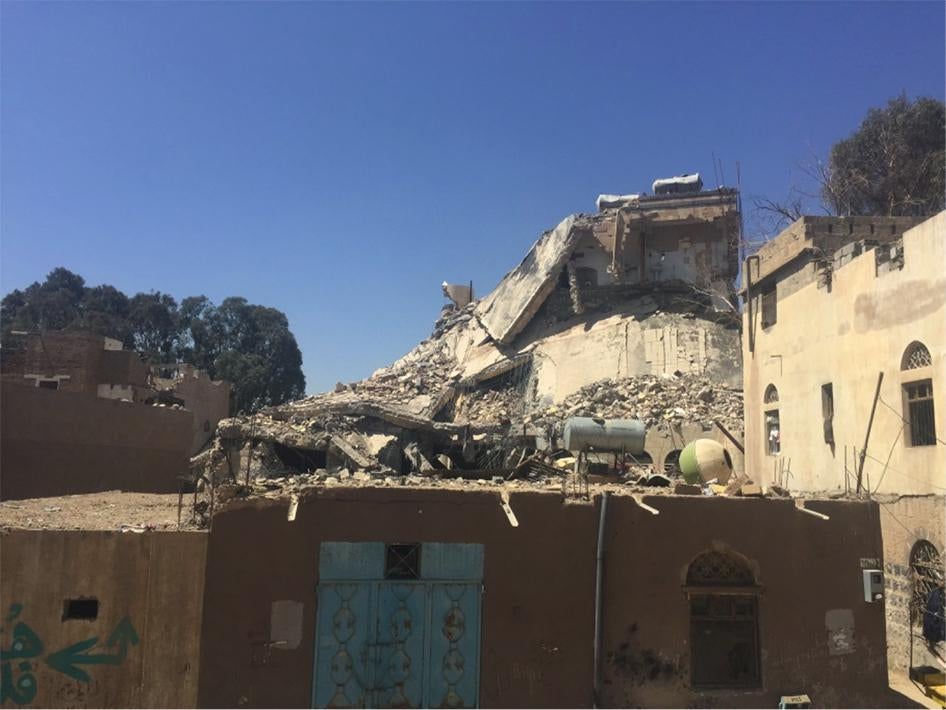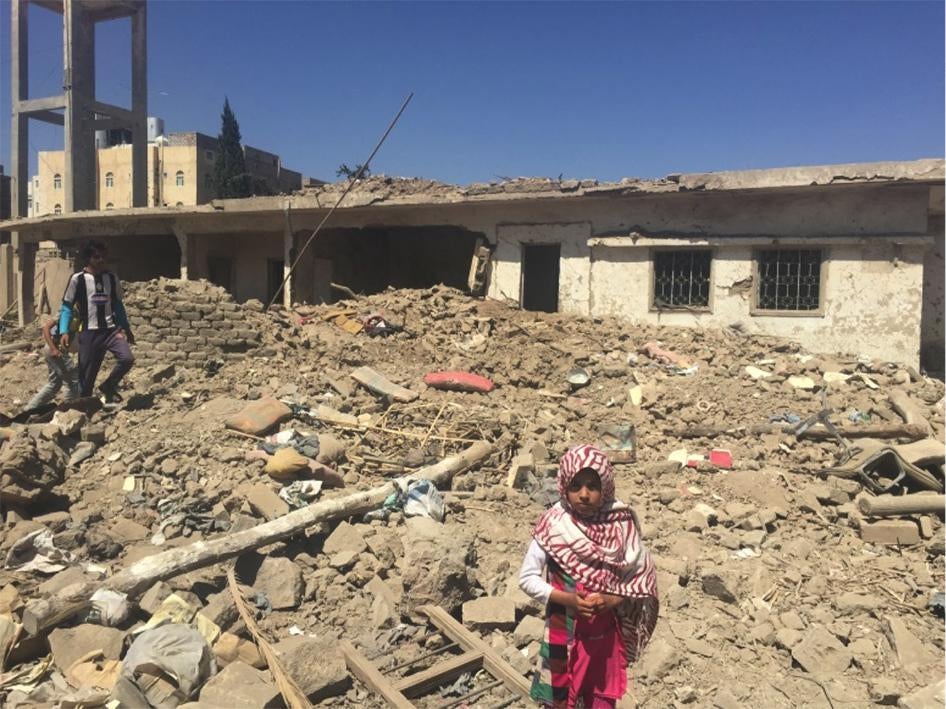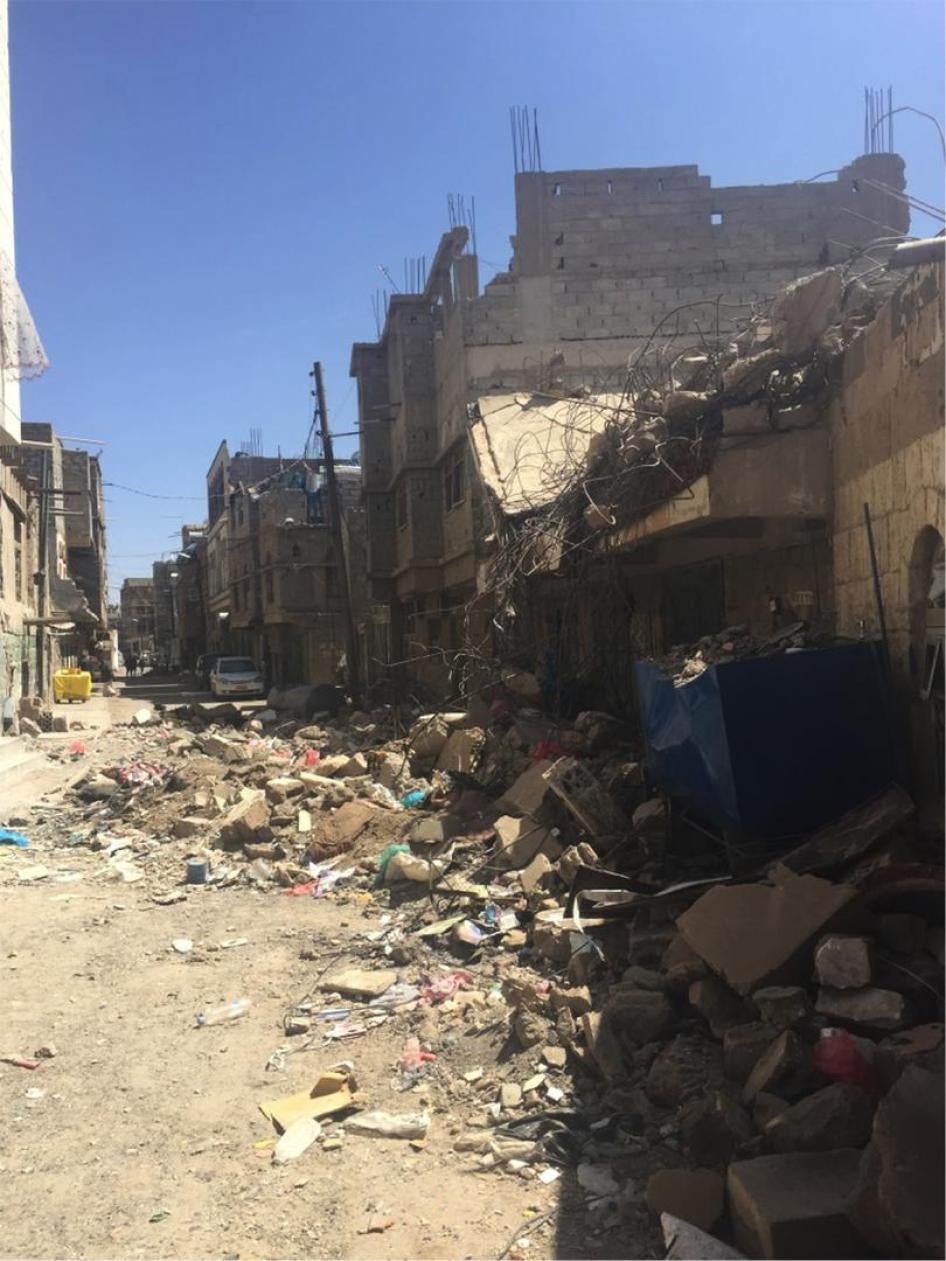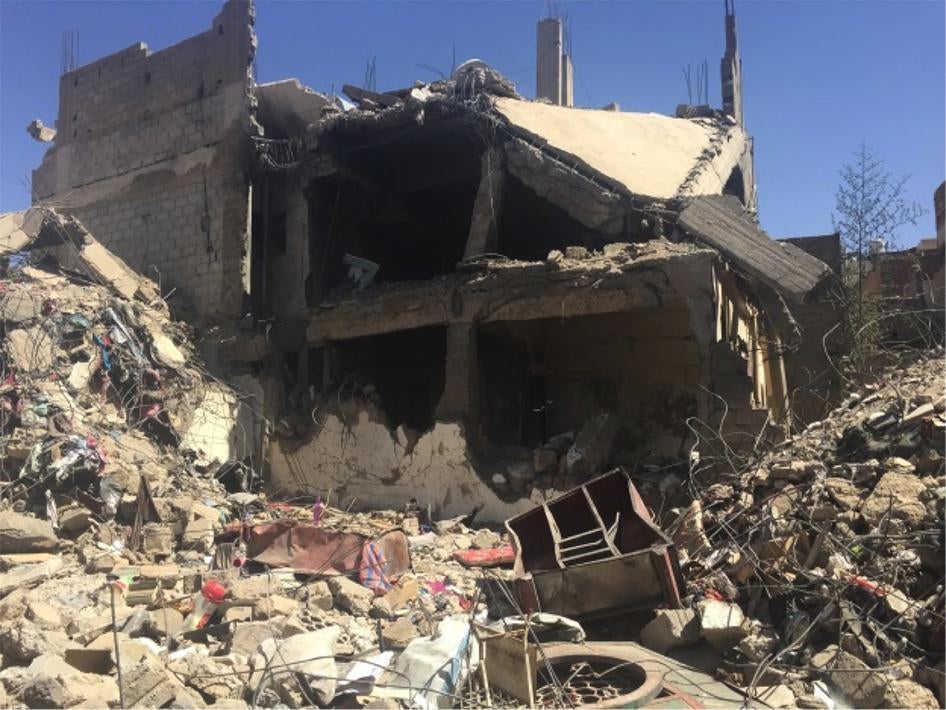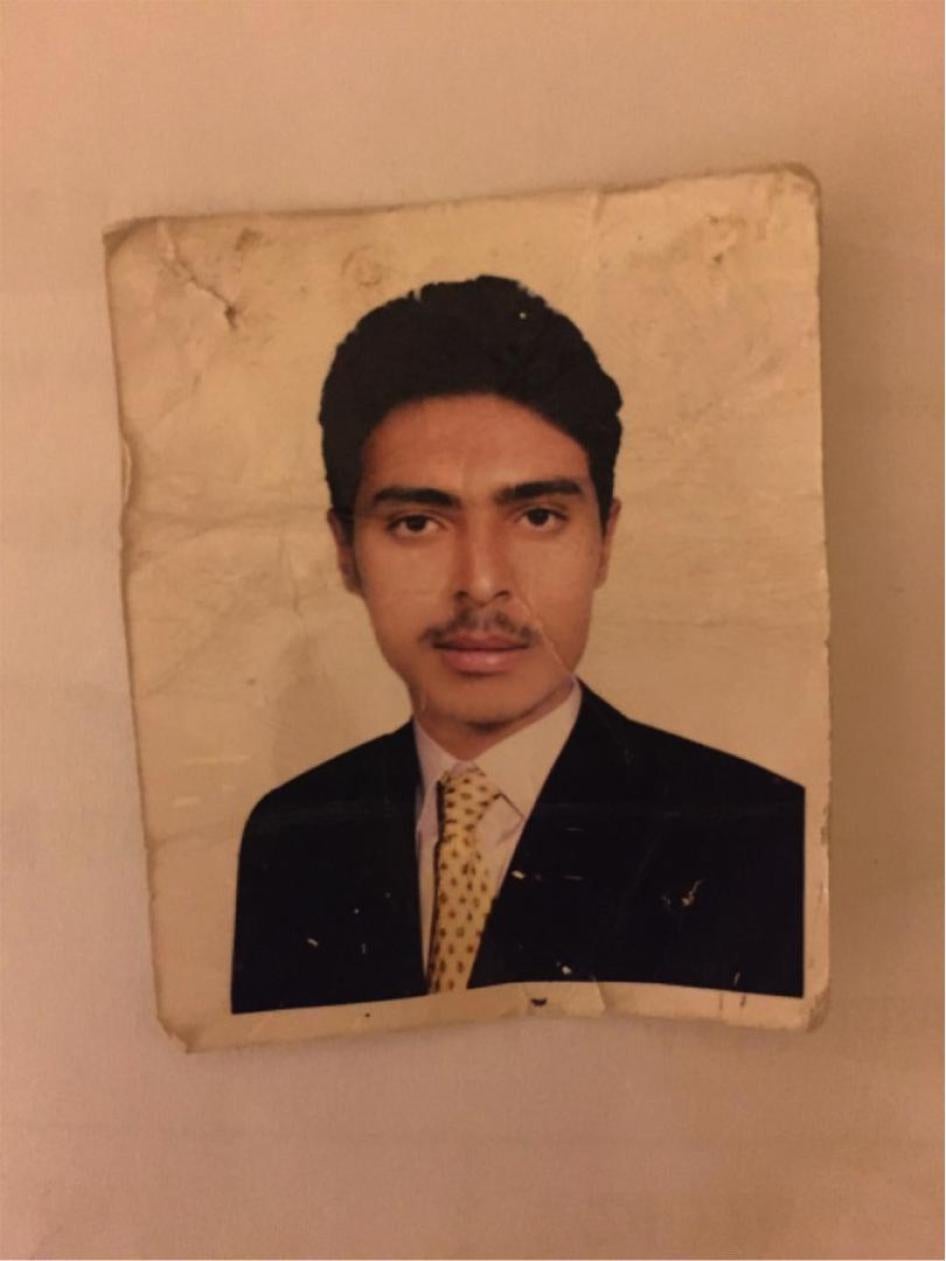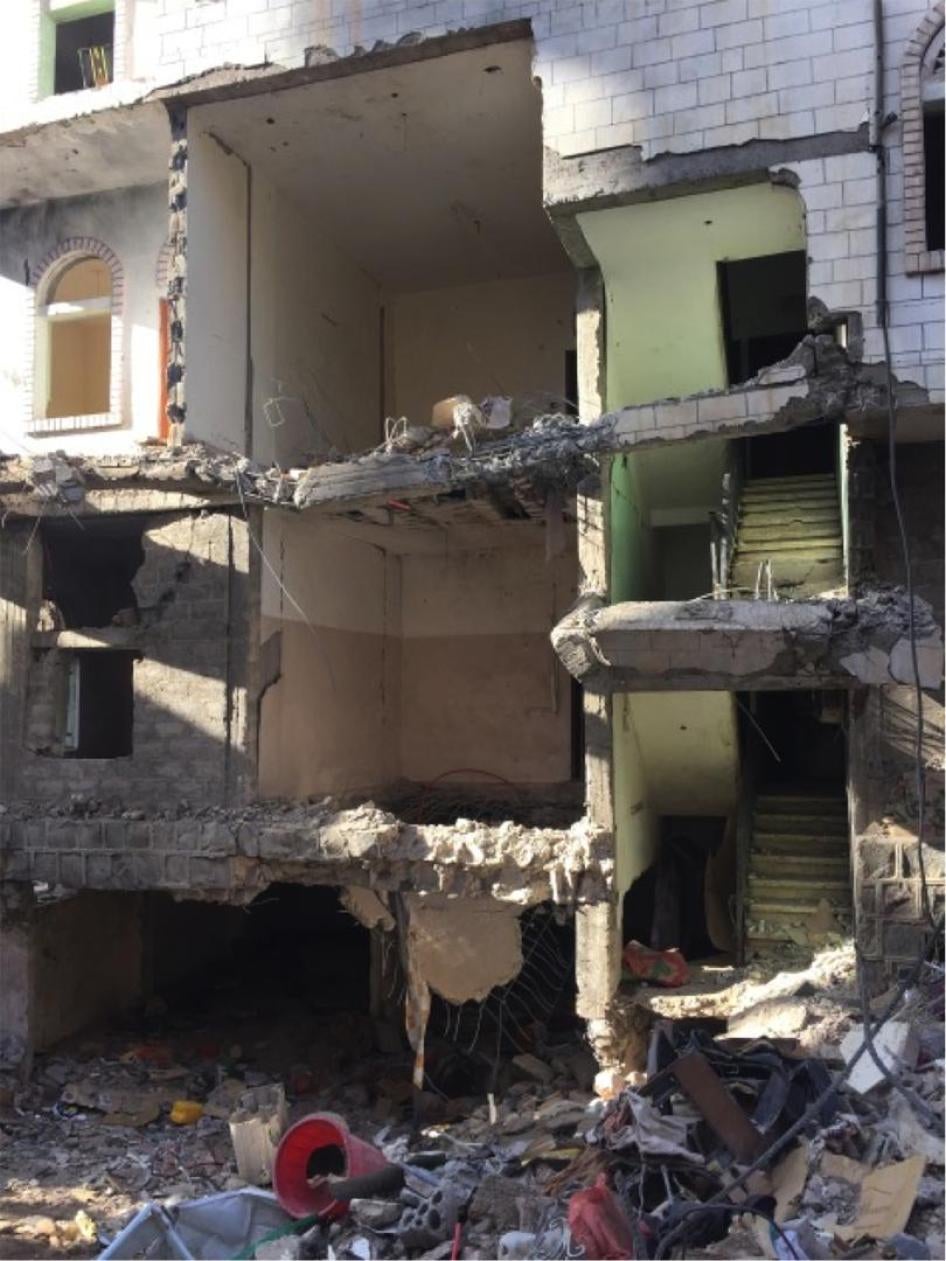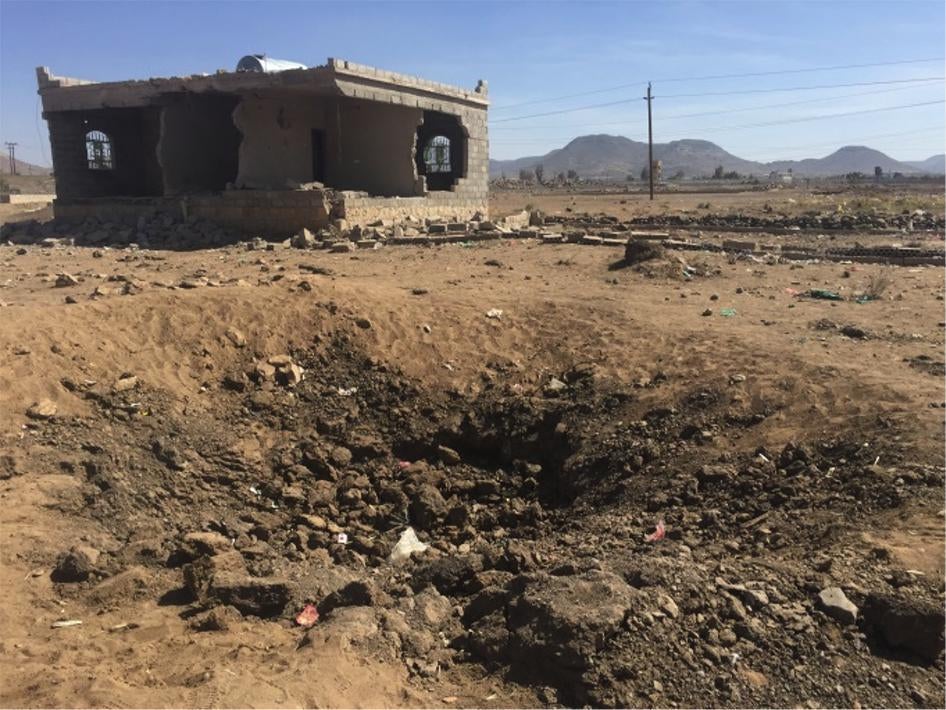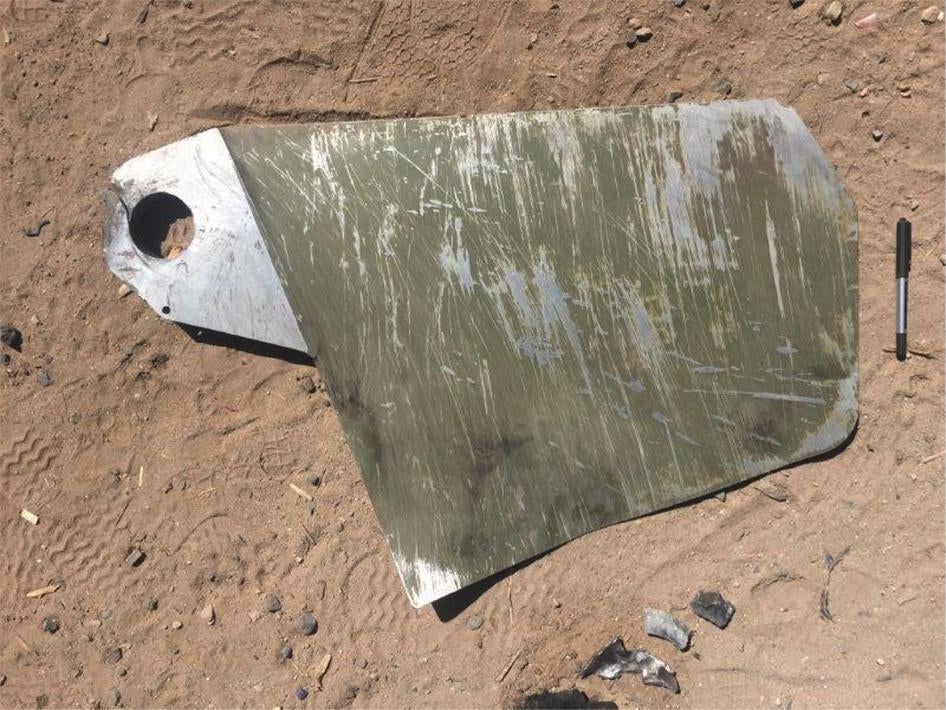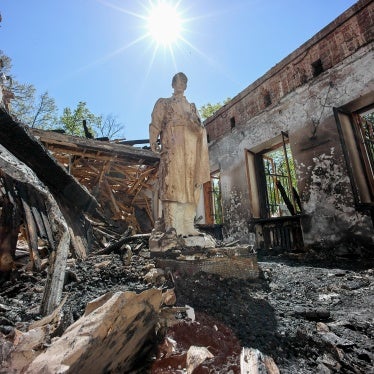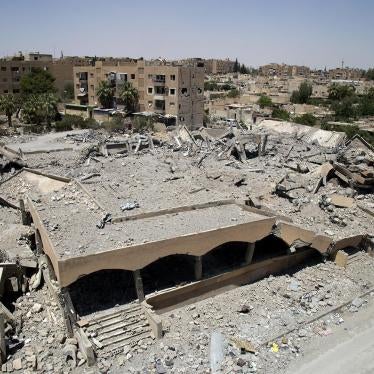(Beirut) – The Saudi Arabia-led coalition fighting in Yemen carried out at least six apparently unlawful airstrikes in residential areas of the capital, Sanaa, in September and October 2015, killing 60 civilians. Coalition members and the United States, as a party to the conflict, are required under the laws of war to investigate such attacks, but they have not.
Human Rights Watch found no evidence of any military target in an airstrike on the Old City and on al-Asbahi neighborhood in September. Airstrikes that caused civilian casualties on homes on Marib Street and in the neighborhoods of Hadda, al-Hassaba, and Thabwa hit 200 meters or more from possible military objectives. These attacks failed to distinguish civilians from military objectives or caused disproportionate civilian loss. Houthi forces in at least two of the attacks put civilians at unnecessary risk by deploying in densely populated neighborhoods. Human Rights Watch visited the sites in late October and interviewed survivors.
“How many civilians will die in unlawful airstrikes in Yemen before the coalition and its US ally investigate what went wrong and who is responsible,” said Joe Stork, deputy Middle East director. “Their disregard for the safety of civilians is appalling.”
Peace talks among the various Yemeni parties in Switzerland ran from December 15-20 before being adjourned. Any future talks should ensure that victims of laws-of-war violations by any party are provided appropriate compensation. Parties to the negotiations should ensure that there is no amnesty for those implicated in serious crimes in violation of international law.
One coalition attack struck a house in Sanaa’s Old City, a UNESCO World Heritage Site, on the night of September 13, killing 18 civilians and wounding many others. Abd al-Khalik Muhammad al-Khamisi, 29, told Human Rights Watch he was sleeping at home with his family in their second-floor apartment, 50 meters from where the strike hit: “I woke up to a loud noise, and felt the glass from all the windows in the room shatter on top of us. My wife and I asked each other why a bomb would drop here; there was no military target near here. It was so loud, so dark.” Al-Khamisi found his mother holding his 2-year-old son – covered in dust but unharmed.
According to the United Nations, most of the 2,500 civilian deaths since the coalition began its military campaign in late March against the Houthis, also known as Allah Ansar, have been from coalition airstrikes. Human Rights Watch is unaware of any investigations by Saudi Arabia or other members of the nine-nation coalition into these or other allegedly unlawful strikes, or of any compensation for victims. The US, by coordinating and directly assisting coalition military operations, is a party to the conflict and as such is obligated to investigate allegedly unlawful attacks in which it took part.
The coalition has repeatedly used aerial bombs with wide-area effect in populated areas, creating the likelihood of civilian casualties even when a military target is hit, Human Rights Watch said. The attacks Human Rights Watch documented used large air-dropped bombs, weighing from 250 kilograms to as much as 1,000 kilograms. These would have blast, thermal, and fragmentation effects in a radius of dozens or hundreds of meters of impact.
Since the conflict in Yemen expanded in March, Human Rights Watch and others have reported on serious laws of war violations by all sides. Human Rights Watch previously documented 10 apparently unlawful coalition airstrikes between April and August in Ibb, Amran, Hajja, Hodaida, Taizz, and Sanaa that killed at least 309 civilians and wounded more than 414. In all of these cases, Human Rights Watch either found no evident military target or that the attack failed to distinguish civilians from military objectives.
An Amnesty International report in December examined five airstrikes that unlawfully struck schools in Hajja, Hodaida, and Sanaa between August and October, killing five civilians and injuring at least 14.
Doctors Without Borders (Medecins Sans Frontieres, MSF) reported that one of its medical clinics was struck in Saada in October, and another in Taizz in December, but has yet to receive any explanation for the attacks on these protected facilities.
The US in November announced the sale of air-dropped munitions to replenish stocks for Saudi Arabia and the United Arab Emirates. The United Kingdom and France have supported the coalition by selling weapons to Saudi Arabia and other coalition members.
Under the laws of war, a party to the conflict may only attack military objectives and must take all feasible precautions to minimize harm to civilians and civilian objects. Attacks in which there is no evident military target, that do not discriminate between civilians and military objectives, or that cause civilian harm disproportionate to the anticipated military gain, are unlawful. Individuals who commit serious violations of the laws of war with criminal intent are responsible for war crimes.
Warring parties must also avoid deploying in densely populated areas and remove civilians in the vicinity of their military forces to the extent feasible. Violations of the laws of war by one party to the conflict do not justify violations by the other.
The UN Security Council should emphasize to all warring parties in Yemen that those responsible for violations of international human rights and humanitarian law should be held accountable and may be subject to travel bans and asset freezes, Human Rights Watch said. The UN Human Rights Council should create an independent, international inquiry into alleged violations of the laws of war by all sides.
“The Saudi-led coalition has repeatedly struck houses, schools, and hospitals where no military target was in sight,” Stork said. “The countries best positioned to stop the coalition from carrying out such heinous violations, notably the US and UK, need to weigh in heavily or find themselves complicit in the abuses.”
Hadda Neighborhood, Sanaa
Since the beginning of the current fighting in March, coalition aircraft have frequently attacked the Hadda compound of the Special Security Forces, a paramilitary force under the control of the interior minister and currently acting on the orders by the Houthis. Sanad Ali al-Badawi, 35, who lives about 200 meters away, told Human Rights Watch that on September 4, between 9 p.m. and midnight, five coalition airstrikes hit the Special Security Forces compound.
A sixth strike, at about 1:15 a.m. on September 5, hit the four-story apartment building where the al-Badawi family lives. Three civilians were killed: a woman and two children.
Al-Badawi, whose father owns the apartment building, told Human Rights Watch that he had been sleeping:
I woke up with bricks on top of me. I could hear my brother yelling my name. He pushed open the door to my bedroom, threw all the debris that was blocking his path out of the way, and helped me get out. We went downstairs to where my parents and younger brother sleep – they were all okay. Then we went to check on my 17-year-old sister, Sana. The walls to her room had been blown off and her room was full of dust. The roof had collapsed on top of her room, and the floor had given way from under her, so her bed had fallen two floors down.
Al-Badawi’s family called for help from the police, the Houthi authorities, and passers-by, but, al-Badawi said, all refused, saying they feared another strike might follow. At 3 a.m., nearly two hours later, he and other family members were able to pull Sana out of the rubble, still alive, and take her to the hospital. At 3:50 a.m., doctors pronounced her dead.
The blast tore away the wall of the room occupied by al-Badawi’s father, Saleh al-Badawi, 55, injuring his neck and back. “I assumed the strike was on the security compound nearby,” he said. “It took me awhile to realize it had hit my house and that the room I was in was now wide open to the world.” His wife, Mahlia Saleh, 50, suffered significant hearing loss in both ears from the explosion.
A Syrian family was leasing the top-floor apartment. The mother, Rimaz, 35, lost her leg and died that night. Her son, Nizar, 8, died from wounds eight days later.
Sanad Ali Al-Badawi said that the blast blew the family’s safe, containing the equivalent of about US$18,500 in cash, from the third floor to the street. Neighbors later told him that they saw armed men in a military vehicle take the safe away within hours of the strike. The family contacted the Houthi authorities to request the return of the safe, but had not received a response.
Marib Street, Sanaa
On September 18, at about 10:30 p.m., coalition aircraft struck a brick house next to an unused iron lathe workshop. The airstrike damaged the house and destroyed the workshop, an aluminum-sheet roof over a metal frame. Five civilians, including a woman and a child, were killed, and another eight were seriously wounded.
Earlier that evening, heavy strikes began on the Interior Ministry compound, a kilometer away. Ibrahim Ateeq al-Jihm and his brother Fayez left their house and, from a street corner in their neighborhood, watched as another strike hit a market, Souq Bathar, at a roundabout about a kilometer away.
Al-Jihm told Human Rights Watch:
[M]y brother shouted, “Let’s go home now! It’s not safe to stay here.” As we were walking home, I suddenly found myself flying in the air and then thrown to the ground. I was covered with stones and dust. There was smoke everywhere and I was covered in blood. I was having difficulty breathing as if someone was squeezing my chest tightly. I finally stood up and looked around me, trying to find my brother – he was lying next to me.
His brother was not hurt, but al-Jihm saw three other people lying on the ground nearby, covered in rubble. One, Walid Fadel Muhammad Thabet, was not moving. The other two – one of whom works in the iron workshop and the other at an aluminum workshop – were moaning and convulsing. The two brothers ran home to check on their family and found the cousin of one of the renters in the building badly wounded. They took him to the hospital.
Three witnesses said that this was the first airstrike in the area. Six days later, on September 24, coalition aircraft began bombing the Military Police headquarters, 350 meters from where the first strike hit. Within four days the coalition had carried out at least two dozen strikes on the headquarters.
Old City, Sanaa
On September 18, at 11:30 p.m., an airstrike hit Sanaa’s Old City and killed 13 civilians, including two women and seven children, and wounded at least 12. It destroyed one home and severely damaged seven others. UNESCO, the UN cultural organization, declared the Old City a World Heritage Site in 1986 because of its 6,000 houses and 100 mosques built before the 11th century. UNESCO added the Old City to its 2015 List of World Heritage in Danger.
Adel al-Maswari, 19, said he was home eating dinner with 10 family members at the time of the attack. He said that he first heard a plane and then an explosion, and the room filled with dust and ash. The munition had exploded about 20 meters away and sent metal fragments through the house. Al-Maswari and his relatives ran outside, where they saw many other people and heard screaming. It was only after a few minutes that he saw that the home of his neighbor Hafth Allah al-Aini had been hit and the building was in ruins. All 10 immediate members of the al-Aini family, ages 4 to 38 years, died in the attack. Houthi officers came to help rescue any survivors, Al-Maswari said.
Saudi al-Alafa, 42, lived with five family members in a home 10 meters from al-Aini’s house. He said that before the house was hit, he had been standing outside, looking up at the sky, because earlier that evening there had been multiple strikes on the neighborhood of al-Hassaba, two to three kilometers away. Later he learned that those strikes had targeted the Interior Ministry, the home of former President Ali Abdullah Saleh, and the Military Police headquarters. As he stood there, he heard a plane and then a whizzing sound, and was thrown against the wall of his house:
I smelled smoke and there was dust everywhere, but I didn’t hear the explosion or even realize that it happened right in front of me; I just felt the pressure [from the explosion]. After a few seconds, I started to hear screams from inside my house. Four members of my family were wounded.
Al-Alafa said two of his sons and two of his daughters were hurt, but not seriously. Then al-Alafa turned his attention to his neighbors:
I ran over to al-Aini’s home to see how I could help. There was sand burying the house up to the second floor. I saw Sobhiya, who’s 50, crawling in the sand. She and her husband, Saleh al-Aini, who’s 60, and a cousin of Hafth, lived in a room on the top floor. She had been thrown from the top floor in the blast, but her husband was still stuck at the top. A neighbor and I helped get him down. Then we came back and started digging, even though we were really scared there might be another strike. We were digging from midnight until 8:30 a.m.
Abd al-Khalik Muhammad al-Khamisi, who lived nearby, said that after the attack, he and his family remained in their home, fearing another strike. He watched from the windows as neighbors spent the next nine hours trying to rescue the al-Aini family.
Muhammad al-Jalal, 33, a neighbor, said he had helped dig out members of al-Aini family, who seemed to have died instantly:
All of them still had food in their mouths. Houria Saad al-Hudiad, al-Aini’s wife, was still holding a glass in one hand and a piece of bread in the other. Finally, at around 8:30 a.m., we were able to get Malak [a 4 year-old] out. She was gasping for breath. She died at the hospital shortly afterward.
Al-Jalal had been sitting on a stoop watching children play when the blast struck 20 meters away:
I heard a whizzing sound then I saw a bright light. I was so scared – I thought I would die at that moment. I was in shock. There was glass everywhere, bricks smashed, and the metal from the doors of the buildings flying. I ran toward the home of Yahya Yahya al-Asaba, where two men and a boy had been outside the house setting up a small stall that they were hoping to turn into a shop front. I first saw one of them, Yahya – he had lost all the skin on his right arm to the bone. I tried to pick him up around his waist, but my hands went straight through him. He had a big cut in his neck, which we wrapped a scarf around to try to stop the bleeding.
Al-Asaba, 35, died that day.
Al-Jalal said that 14-year-old Qatin Saleh Al-Rawahi had a metal fragment in his abdomen and his legs seemed to be bent together. He died two days later. Isam Yehya Asabah, 25, was lying a few meters away. He died a week later. All the Old City residents Human Rights Watch interviewed said there were no military targets in the Old City. Those interviewed said that residents do not allow heavy weaponry to be brought into the Old City. The cluster of houses is off the road, so there would be no passing military vehicles. However, during the visit, when a plane flew overhead, researchers heard three bursts of fire from anti-aircraft guns close by.
Al-Hassaba Neighborhood, Sanaa
On September 21, starting at about 4:30 a.m., four airstrikes hit houses in Sanaa’s al-Hassaba neighborhood, where the Houthis had placed civilians at risk by deploying their forces in a densely populated residential area. The strikes destroyed four homes and damaged at least 11 others. The fourth strike killed 20 civilians. They included 18 members of an extended family, six of them women and 11 of them children.
Six residents told Human Rights Watch the first strike hit the home of Sam al-Ahmar, which Houthi fighters had been occupying for a year. Three residents said that the Houthis had evacuated the home the night before the strikes, leaving three guards, one of whom was wounded in the strike. A few minutes after the strike, a fire truck came, put out the fire, and quickly drove away. Human Rights Watch saw the burned remnants of several military vehicles, but a Houthi guard prevented researchers from entering the area or taking more than three photographs.
The residents said that as the fire truck was leaving, another strike hit the multi-story home of the Aqlan family, next to al-Ahmar’s house. The Aqlan family had fled their home after the first strike.
About 10 to 15 minutes later, a third strike hit an open yard across the street from both houses destroying a single-story home where 10 people lived, though none were home. The strike also damaged a second single-story building on the property where eight people lived, wounding Walid al-Numais, 17, and four other buildings.
Hamran Ghalib Abass, 45, a sweets seller, came outside at 5:30 a.m., about 15 minutes after the strikes. He said he heard his neighbor across the street, Muhammad Munfarih, calling to his son from the gate of his house, telling him to get inside:
As they went inside, I heard a plane fly overhead and a whizzing. The pressure [of the explosion] threw me right through the open door of my building. My son came running down, screaming that they had hit our house, which is what he thought because of all of the damage to our house. I heard Munfarih yelling, “Please, someone help!”
In fact, the fourth strike had hit Munfarih’s multi-story home, about 260 meters down the street from the al-Ahmar home. The strike killed 18 members of the Munfarih family, including 10 children, and two neighbors, one of them a 13-year-old boy. The strike destroyed the Munfarih house and severely damaged four other multistory houses and one single-story house.
Muhammad Abdullah al-Hadrami, 70, the imam of nearby al-Hadaya mosque, said he was standing on the street facing Munfarih’s home when the fourth strike hit. He said that he saw a bright light and then heard people crying out for help. He could not see because of all the dust, so he got onto the ground and crawled toward the house. The first to enter, he saw Munfarih’s wife and daughter-in-law, buried up to their necks. He and other neighbors dug them out. They were the only two family members to survive the blast.
Munfarih and other members of his family died in the wreckage of their home before their neighbors could get them to the hospital.
Al-Asbahi Neighborhood, Sanaa
On September 23, at about 7:30 a.m., two airstrikes hit Sanaa’s al-Asbahi neighborhood. The strikes killed 19 civilians, including two women and 10 children. The strikes destroyed three homes and damaged a four-story apartment building and three other multi-story houses.
A local resident, Idris Radman, 27, showed Human Rights Watch the effect of the first strike, which destroyed three single-story houses. In the home of a taxi driver, Ahmed Maghreb, two people were killed. In the home of a police inspector, Ali al-Gharashi, seven were killed. In the third, the home of an oil company worker, Sayid al-Thubai, five were wounded.
“I was sleeping with my family, and suddenly at around 7:30 a.m. something woke me and terrified me – a very extreme loud sound, an explosion,” said Najeeb Hussein, a 43-year-old oil industry worker.
Five minutes later, the second strike hit a four-story apartment building, destroying the south-facing façade and damaging three more multi-story houses. The building housed the families of a barber, a painter, and a plumber. Mukhtar Dadya’s wife and three children were killed. Hisham Ghamdan, 35, a neighbor said that Dadya survived because he had gone to help at the scene of the first strike. “I was next to him when he found out that his whole family had been killed,” Ghamdan said. “It was a tragic, indescribable scene.”
Ghamdan said he was sleeping when the first airstrike hit:
Suddenly, I heard a very loud sound. I called my son, Ali, 16, to check what happened, because although I was used to hearing the loud sound of airstrikes, this one was very loud, and felt much closer than usual. My son returned within minutes terrified, pale, scared, crying and stuttering, “The rocket hit Ali al-Gharashi house’s, the rocket hit al-Gharashi’s house!”
Zain al-Futaini, 43, who lives opposite the second apartment building that was hit, said he was lying in bed when he heard the first strike hit and then minutes later, the second. He thought they were probably not close because he did not know of any military targets in the area. But his building started to shake and bricks fell. He went outside:
I saw one woman with a wound to her head, three children and two men lying on the ground, and one woman cut in half at the waist. My neighbors and I pulled three women and two children out of the basement of the apartment building.
One [other] kid, who lived on the third floor of the building, had gone out onto the balcony after the first bomb to see what had happened, so when the second strike hit his building, he was blasted off the balcony and splattered onto the façade of the building opposite.
Local residents said that no other airstrikes had hit the area. The home of Ali al-Thafif, a commander in the former Republican Guard, which has supported the Houthis, is 50 meters from the first strike site and 115 meters from second site. He and his family left their home at the beginning of the war, neighbors said, so it would not be a legitimate military target. An earlier airstrike hit his village home in Bayt al-Thafif, in Hamdan directorate, on June 8.
Thabwa, Sanaa
On October 26, at about 11:30 a.m., an airstrike hit Thabwa, a southern suburb of Sanaa, wounding a woman and her 3-year-old son. The strike destroyed two homes.
Abdullah Hussein al-Futohy, whose house was just 10 meters from where the bomb struck, said he heard a whizzing sound:
My wife fearfully said, “There is a rocket coming toward us.” I was scared. Suddenly we heard the explosion and the whole of our house began to collapse on top of our heads. Two-thirds of the house collapsed. My wife lost consciousness - she was covered with blood. I heard my 3-year-old son screaming, “Baba! Baba!”
I ran to him, dug through the rubble, and dragged him out. He was crying and his legs were bleeding. I carried him outside to my neighbor Haj Muhammad’s house, and gave them my son. I then ran back to my house to check on my wife. All of that time, I thought my 7-year-old daughter, Sali, had been killed in the explosion -- she had just left a few minutes before the explosion to go to our neighbor’s house. Suddenly I heard my Sali calling me, “Baba! Baba! I thought all of you were killed.”
Al-Futohy’s daughter was fine but his wife, Elham Naje, 27, was bleeding from her chest. He took her to the hospital. Human Rights Watch was not able to reach the family again to learn more about her condition.
The bomb fell in the general vicinity of several military installations, including al-Thabwa military camp, 1.2 kilometers east, and Raymat Humaid military camp, three kilometers west. The home of the former First Armored Division commander, Gen. Ali Mohsen al-Ahmar, was 250 meters west. According to residents, at least a dozen Houthis had been occupying his home for several months, placing civilians in the area at grave risk of attack. The airstrike did not damage Al-Ahmar’s house.
At the site, Human Rights Watch found the manufacturing markings of a guidance fin assembly for the laser-guided Paveway III bomb, which is produced by the US company Raytheon. These are very accurate weapons when properly used. It was not possible to discern whether the bomb was deliberately guided to the impact point or whether a malfunction of the guidance system caused the bomb to strike a point that had not been targeted.
